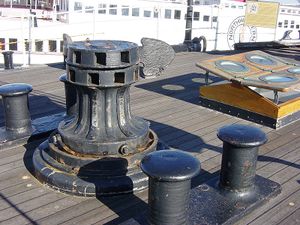Capstan
A capstan is a vertical-axled rotating machine developed for use on sailing ships to apply force to ropes, cables, and hawsers. The principle is similar to that of the windlass, which has a horizontal axle.
In its earliest form, the capstan consisted of a timber mounted vertically through a vessel's structure which was free to rotate. Levers, known as bars, were inserted through holes at the top of the timber and used to turn the capstan. A rope wrapped several turns around the drum was thus hauled upon. A rudimentary ratchet was provided to hold the tension. The ropes were always wound in a clockwise direction (seen from above).
Capstans evolved to consist of a wooden drum or barrel mounted on an iron axle. Two barrels on a common axle were used frequently to allow men on two decks to apply force to the bars. Later capstans were made entirely of iron.
For spanking
Aboard ships, including training ships, a boy who was to be punished informally (for a minor offense) was often bent over the capstan and then given a number of strokes, for example with a rope's end or a cane, on his posterior.
An alternative was to use a bitt for this purpose. Bitts are smaller and lower than capstans.
For more formal chastisement, the "kissing the gunner's daughter" position was employed.
